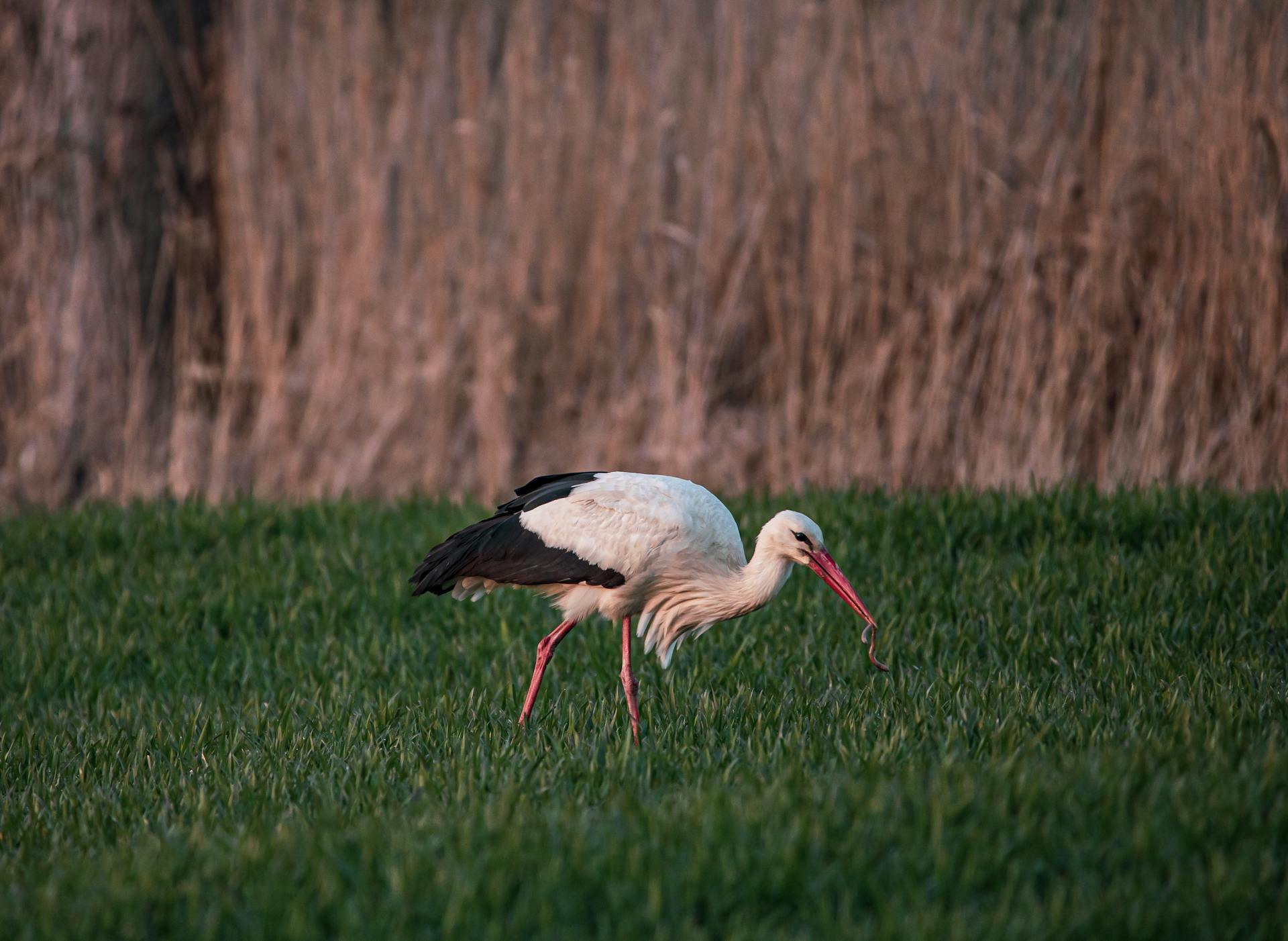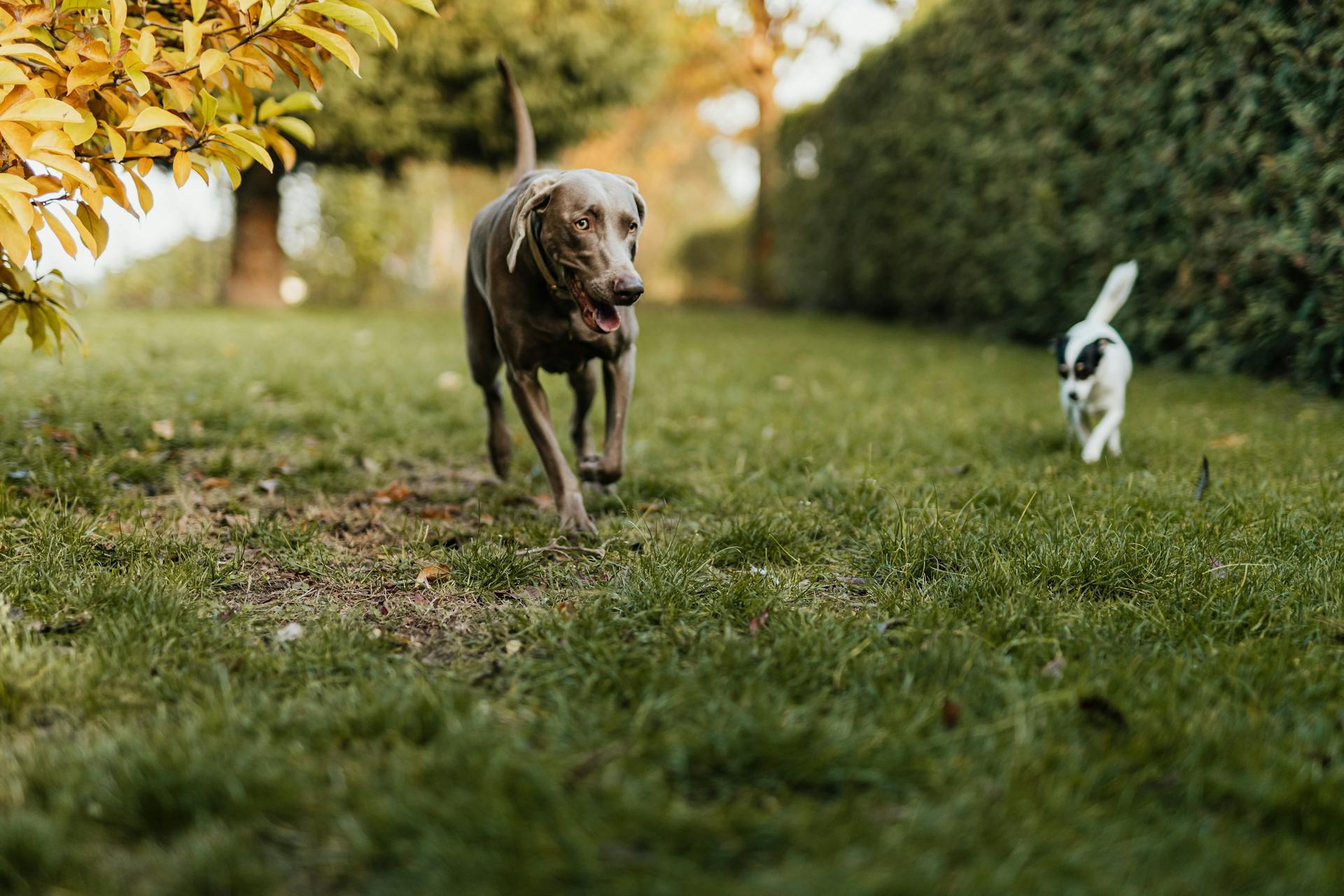
Angiostrongylus vasorum, also known as French heartworm, is a parasitic nematode that affects dogs worldwide.
This parasite has a complex life cycle that involves multiple hosts, including snails, slugs, and rodents.
The life cycle begins with the ingestion of infected snail or slug tissue by a rodent, which then serves as an intermediate host.
The parasite then develops into an adult worm in the rodent's lungs.
Adult worms mate and produce microfilariae, which are ingested by snails or slugs.
The microfilariae develop into infective third-stage larvae within the snail or slug, which can then infect a new host.
Snails and slugs are essential for the transmission of Angiostrongylus vasorum to dogs, as they can carry the infective larvae.
Dogs become infected through the ingestion of infected snail or slug tissue, often while exploring outdoors or eating contaminated prey.
You might like: Toxocara Canis Treatment in Dogs
Life Cycle and Transmission
Angiostrongylus vasorum has a multi-host, multi-stage, indirect life cycle. This means it involves multiple hosts and stages, making it a complex process.
Dogs are the definitive hosts, while gastropod molluscs (slugs and snails) are the intermediate hosts. Wild canids, such as red foxes, act as reservoirs. Dogs can become infected by accidentally or intentionally ingesting third-stage larvae from intermediate hosts or from slime trails and paratenic hosts like frogs.
The type of habitat is a significant factor in determining the opportunities for dogs to encounter gastropods. Complex vegetated areas attract gastropods due to better food sources, moisture retention, and ease of movement.
Gastropods are more likely to be found in vegetated environments, and high-risk species are common in the evening and when humidity is high. Climate change is expected to alter gastropod community dynamics and A. vasorum transmission, particularly affecting species like the "Spanish slug".
Here's a breakdown of the life cycle stages:
- L3 larvae are ingested by a definitive host (fox or dog)
- L3 larvae migrate to the mesenteric lymph nodes and molt to L4 and L5
- L5 larvae migrate through the portal circulation and end up in the pulmonary artery or right side of the heart
- Adult worms mate and produce eggs, which move to the alveolar capillaries and hatch to L1 larvae
- L1 larvae burrow through the alveolar and are coughed up and swallowed, passing in the feces of infected canids
The pre-patent period is about 6-10 weeks, and adult worms can live for 2 years.
Life Cycle and Transmission
The life cycle of Angiostrongylus vasorum is a complex process that involves multiple hosts and stages. Dogs become infected by accidentally or intentionally ingesting third-stage larvae from gastropod intermediate hosts, such as slugs and snails, or from paratenic hosts like frogs.

The type of habitat is a major factor in determining the opportunities for dogs to encounter gastropods. Dogs are more likely to encounter gastropods in complex vegetated areas with better food sources, moisture retention, and ease of movement.
Gastropods are active in these environments, especially larger slugs in autumn, posing a higher risk to dogs. Smaller slugs, on the other hand, are active year-round.
Dogs are less likely to encounter gastropods on hard surfaces. High-risk gastropod species are especially common in the evening and when humidity is high.
A vasorum prevalence in gastropods can vary geographically within the UK, influenced by timing and environmental factors. This can impact the transmission dynamics of the parasite.
Here's a breakdown of the life cycle:
- Stage 1: L3 larvae are ingested by a definitive host, primarily the fox or dog.
- Stage 2: The L3 larvae migrate to the mesenteric lymph nodes and molt to L4 and L5.
- Stage 3: The L5 larvae migrate through the portal circulation and end up at the pulmonary artery or right side of the heart.
- Stage 4: The adults mate and produce eggs.
- Stage 5: The eggs move to the alveolar capillaries via the circulation and hatch to L1 larvae.
- Stage 6: The L1 larvae burrow through the alveolar and are then coughed up and swallowed.
- Stage 7: L1 larvae are passed in the feces of infected canids.
- Stage 8: The L1 larvae infect intermediate hosts (primarily slugs and snails) by penetrating the foot of the mollusc and develop to L3 within.
Species
The French heartworm, also known as Angiostrongylus vasorum, is a parasite that affects foxes and other canids.
Angiostrongylus vasorum can also find its way into dogs, which are not its natural hosts.
Hosts

Angiostrongylus vasorum has a complex life cycle, and understanding its hosts is key to grasping how it spreads. The natural intermediate hosts are land slugs, land snails, and freshwater snails, with the Arion ater being a natural host.
These hosts play a crucial role in the parasite's life cycle, allowing it to complete its development before infecting its next host. The natural definitive hosts are domestic dogs and various other carnivores, including red foxes, pampas foxes, hoary foxes, and wolves.
Some of the natural definitive hosts include:
- Red fox (Vulpes vulpes)
- Pampas fox (Pseudalopex gymnocerus)
- Hoary fox (Pseudalopex vetulus)
- Crab-eating fox (Dusicyon thous)
- Wolf (Canis lupus)
- Coyote (Canis latrans)
- African desert fox (Fennecus zerda)
- European badger (Meles meles)
Natural paratenic hosts, which don't allow the parasite to complete its development but can still transmit it, include frogs, lizards, mice, and rats.
Disease and Symptoms
Disease due to Ang. vasorum is an inflammatory reaction with the subsequent involvement of the surrounding lung tissue, which may be accompanied by interstitial pneumonia, emphysema, thromboarteritis, coagulopathis, anemia, melena, hemoptysis, and congestive right heart failure.
Dogs infected with Ang. vasorum may show no clinical signs at all. Others may experience mild to severe clinical signs, and in some cases, death.
Exercise intolerance, coughing, and dyspnea are common symptoms in dogs infected with Ang. vasorum. These symptoms can progress to right heart failure in advanced cases, characterized by ascites.
Compromised haemostasis can also occur in dogs infected with Ang. vasorum. In rare cases, neurological signs may be observed due to larval migrans in the central nervous system.
The following symptoms can be associated with Ang. vasorum infection:
- Interstitial pneumonia
- Emphysema
- Thromboarteritis
- Coagulopathis
- Anemia
- Melena
- Hemoptysis
- Ascites
- Right heart failure
Prevention and Control
Prevention and control are crucial when it comes to Angiostrongylus vasorum. Preventing dogs from feeding outdoors, walking in damp environments, and keeping dog toys indoors can minimize exposure to the parasite.
Regular cleaning of outdoor water dishes is also essential. Promptly removing dog faeces is a must, as it can help reduce environmental contamination.
Dogs at high risk of exposure, such as snail or slug eaters, or those living in endemic areas, should receive monthly preventive treatment. This can include anthelmintic treatments containing moxidectin or milbemycin oxime.
For another approach, see: Parasites in Dogs
In endemic areas, monthly application of anthelmintic treatments can prevent angiostrongylosis and patent infection with Angiostrongylus vasorum. This is especially important for dogs that are at high risk of exposure.
Here are some preventive measures you can take:
- Prevent dogs from feeding outdoors
- Walk dogs in dry environments
- Keep dog toys indoors
- Regularly clean outdoor water dishes
- Promptly remove dog faeces
- Consider monthly preventive treatment for high-risk dogs
In uncertain areas, testing prior to surgery, in suspected cases, and annual testing of young dogs can help determine endemic status and inform risk-based advice.
Frequently Asked Questions
Is Angiostrongylus vasorum a lungworm?
Yes, Angiostrongylus vasorum is commonly referred to as a "lungworm" due to its effects on the lungs, but it's actually a parasitic nematode that primarily affects the heart and pulmonary arteries.
Sources
- https://capcvet.org/guidelines/angiostrongylus-vasorum/
- https://www.vettimes.co.uk/angiostrongylus-vasorum-where-is-it-in-uk-and-what-are-risks/
- https://en.wikipedia.org/wiki/Angiostrongylus_vasorum
- https://wcvm.usask.ca/learnaboutparasites/parasites/angiostrongylus-vasorum.php
- https://www.mdpi.com/journal/pathogens/special_issues/Pathogenesis_Diagnostics_Angiostrongylus_vasorum_Infection
Featured Images: pexels.com


